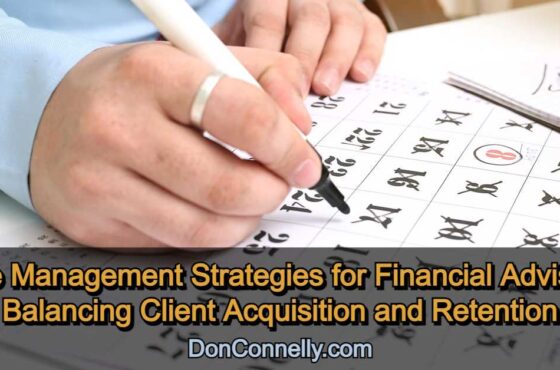The Paradox of Financial Education: How Too Much Knowledge Can Cost You Clients
 Financial advisors constantly walk a tightrope between empowering clients and overwhelming them.
Financial advisors constantly walk a tightrope between empowering clients and overwhelming them.
While financial literacy is crucial for informed decision-making, overeducating prospects and clients can backfire, resulting in the loss of an account. This phenomenon can be better understood by examining the psychology of financial decision-making and the delicate advisor-client relationship.
Information overload and analysis paralysis
Financial markets are complex beasts, brimming with jargon, asset classes, and ever-shifting trends. Bombarding a client with excessive information can trigger information overload, a state of cognitive strain caused by an influx of data exceeding their capacity to process it. This can lead to:
- Analysis paralysis: Faced with myriad options, clients become paralyzed, unable to make a decision for fear of making a bad one.
- Decision fatigue: The constant evaluation of intricate details can deplete a client’s mental resources, making them less willing and able to engage in the decision-making process.
- Loss of trust: Clients may perceive the advisor’s excessive explanations as a lack of confidence in their ability to grasp basic concepts, eroding trust in the advisor’s expertise.
Consider this analogy: Imagine taking your car to a mechanic. They explain the problem but then delve into the intricacies of engine combustion and valve timing. While fascinating, this might leave you feeling overwhelmed and reliant on their expertise rather than empowered to make informed decisions about repairs. Most people don’t want to hear the intricate details of a car repair—just that it’s fixed and safe to drive.
The Dunning-Kruger effect and the comfort zone
The Dunning-Kruger effect posits that people with limited knowledge tend to overestimate their competence. A client with minimal financial knowledge might initially feel confident navigating basic investment options. However, as the advisor delves deeper into explanations, the client may encounter concepts they don’t understand. This lack of comprehension can trigger a sense of inadequacy, causing the client to retreat from active participation.
Clients who feel out of their depth may:
- Question the advisor’s recommendations: They might second-guess suggestions, perceiving them as overly complex or risky due to their limited understanding.
- Seek a second opinion: Feeling unsure, they might seek an advisor who offers simpler explanations, potentially jeopardizing the existing relationship.
- Disengage from the process: Overwhelmed, they may simply defer all decisions to the advisor, creating a dynamic where they feel like passive passengers rather than active participants in their financial future.
The key is to find the sweet spot—to educate clients enough to make them comfortable with the investment strategy but not so much that they feel lost at sea.
The importance of tailoring communication
Effective communication is the cornerstone of any successful advisor-client relationship. This means tailoring your explanations to the client’s financial literacy level and risk tolerance.
Here are some strategies to consider:
- Start with the basics: Before diving into complex topics, ensure the client grasps fundamental concepts like asset allocation, diversification, and risk-adjusted returns.
- Use clear and concise language: Avoid jargon and technical terms. Explain complex concepts using real-world analogies and relatable examples.
- Focus on outcomes, not mechanics: Don’t get bogged down in the intricate workings of financial instruments. Focus on how these instruments can help the client achieve their financial goals.
- Active listening and open-ended questions: Pay close attention to the client’s level of understanding and adjust your communication style accordingly. Encourage questions to gauge their knowledge and identify areas that need clarification.
Striking the balance: Education should create trust, not fear
Financial education is not the enemy. Empowering clients with knowledge fosters trust and strengthens the advisor-client relationship. However, the key is to find the right balance.
Here’s how education, delivered thoughtfully, can benefit your practice:
- Increased client confidence: Clients who understand the rationale behind your recommendations are more likely to feel confident in your guidance and make informed decisions.
- Stronger long-term relationships: Fostering financial literacy positions you as a trusted advisor, not just a product salesperson. This builds stronger, long-term relationships with clients.
- Improved client satisfaction: Clients who feel empowered and in control of their financial future are more likely to be satisfied with your services and less likely to seek alternatives.
Remember:
- Focus on the client’s goals, not your knowledge: Tailor your communication to their needs and aspirations.
- Start simple and build on their understanding: Don’t overwhelm them with information.
- Use clear language and relatable examples: Break down complex concepts into easy-to-grasp pieces.
- Actively listen and address their concerns: Ensure they feel heard and understood.
By striking a balance between education and clarity, you can empower your clients to become active participants in developing their financial strategies.
Watch this 3-minute video to learn how our 24-step training program can help you become brilliant at the basics and take your business to the next level!
See program details and enroll today!
Available as a self-paced program (always open) or as a 12-week coaching program (open only a couple of times a year), this training will change the way you view your practice and will give you an enormous advantage over your competition. Select your format and enroll now!



